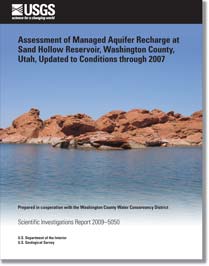 Abstract Abstract
Sand Hollow Reservoir in Washington County, Utah, was completed in March 2002 and is operated primarily as an aquifer storage and recovery project by the Washington County Water Conservancy District (WCWCD). Since its inception in 2002 through 2007, surface-water diversions of about 126,000 acre-feet to Sand Hollow Reservoir have resulted in a generally rising reservoir stage and surface area. Large volumes of runoff during spring 2005–06 allowed the WCWCD to fill the reservoir to a total storage capacity of more than 50,000 acre-feet, with a corresponding surface area of about 1,300 acres and reservoir stage of about 3,060 feet during 2006. During 2007, reservoir stage generally decreased to about 3,040 feet with a surface-water storage volume of about 30,000 acre-feet. Water temperature in the reservoir shows large seasonal variation and has ranged from about 3 to 30°C from 2003 through 2007. Except for anomalously high recharge rates during the first year when the vadose zone beneath the reservoir was becoming saturated, estimated ground-water recharge rates have ranged from 0.01 to 0.09 feet per day. Estimated recharge volumes have ranged from about 200 to 3,500 acre-feet per month from March 2002 through December 2007. Total ground-water recharge during the same period is estimated to have been about 69,000 acre-feet. Estimated evaporation rates have varied from 0.04 to 0.97 feet per month, resulting in evaporation losses of 20 to 1,200 acre-feet per month. Total evaporation from March 2002 through December 2007 is estimated to have been about 25,000 acre-feet. Results of water-quality sampling at monitoring wells indicate that by 2007, managed aquifer recharge had arrived at sites 37 and 36, located 60 and 160 feet from the reservoir, respectively. However, different peak arrival dates for specific conductance, chloride, chloride/bromide ratios, dissolved oxygen, and total dissolved-gas pressures at each monitoring well indicate the complicated nature of interpreting the arrival of managed aquifer recharge water and estimating ground-water travel times. Additional tracers of managed aquifer recharge currently are being considered for further investigation.
|
Part or all of this report is presented in Portable Document Format (PDF); the latest version of Adobe Reader or similar software is required to view it. Download the latest version of Adobe Reader, free of charge. |